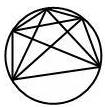 Suppose you take a circle, put some dots along the outside, and then connect them, as in the picture to the left (which has 5 dots on the outside). If only two lines cross at any point, how many regions will the circle be divided into?
Suppose you take a circle, put some dots along the outside, and then connect them, as in the picture to the left (which has 5 dots on the outside). If only two lines cross at any point, how many regions will the circle be divided into?
Let’s find out! If you place 1 dot along the outside you can’t connect it to anything so you get one region (the entire circle). If you place 2 dots along the outside and connect them you divide the circle into 2 regions. By placing 3 dots along the outside you divide the circle into 4 regions.
Looking at the bottom row, if you place 4 dots on the circle and connect them you get 8 regions. Hey, notice that neat 1, 2, 4, 8 pattern of the title? What about five dots?
At this point it’s getting a little hard to keep track of all the regions, so I colored them in the pictures below.
Looking at the middle of the bottom row, putting 5 dots along the edge divides the circle into 16 pieces, as might be expected.
What if there are 6 dots along the outside? And that’s where everything goes terribly wrong. It only divides the circle into 31 pieces, not 32. Putting 7 dots along the outside is even worse: you get 57 pieces.
It turns out that even though the numbers 1, 2, 4, 8, 16, 31 start off as powers of 2, they’re really following the formula , where n is the number of dots on the outside. (Where the heck does that come from, you might wonder? It actually comes from the simpler-looking
(see Wolfram’s Mathworld)).
So much for our nice pattern.


February 20, 2017 at 12:59 pm |
Also, the divisors of 496 (a perfect number) form the sequence {1, 2, 4, 8, 16, 31, 62, 124, 248}